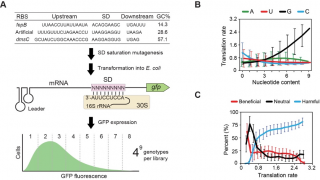May, 2020

Shine-Dalgarno sequences (SD) in prokaryotic mRNA facilitate protein translation by pairing with rRNA in ribosomes. Though conventionally defined as AG-rich motifs, recent genomic surveys reveal great sequence diversity, questioning how SD functions. Here we determined the molecular fitness (i.e. translation efficiency) of 49 synthetic 9-nt SD genotypes in three distinct mRNA contexts in E. coli (Fig. A). We uncovered generic principles governing the SD fitness landscapes: (1) Guanine contents, rather than canonical SD motifs, best predict the fitness of both synthetic and endogenous SD (Fig. B). (2) The genotype-fitness correlation of SD promotes its evolvability by steadily supplying beneficial mutations across fitness landscapes (Fig C). (3) The frequency and magnitude of deleterious mutations increase with background fitness, and adjacent nucleotides in SD exhibit stronger epistasis. Epistasis results from disruption of the continuous base pairing between SD and rRNA. This “chain-breaking” epistasis creates sinkholes in SD fitness landscapes and may profoundly impact the evolution and function of prokaryotic translation initiation and other RNA-mediated processes. Collectively, our work yields functional insights into the SD sequence variation in prokaryotic genomes, identifies a simple design principle to guide bioengineering and bioinformatic analysis of SD, and illuminates the fundamentals of fitness landscapes and molecular evolution.